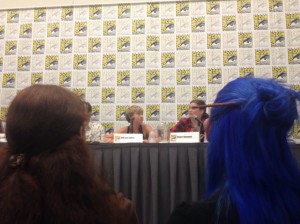By Matthew Jent
To mark the 25th anniversary of Heartbreakers, an action/sci-fi serial originally serialized in Dark Horse Presents, co-creator Anina Bennett brought the conversation about Female Heroes, Then & Now to SDCC.
Anina was joined by her husband and Heartbreakers co-creator Paul Guinan, Geek & Sundry’s Kiala Kazebee, comics/movie/video game writer Jimmy Palmiotti, Monkeybrain Co-Publisher and IDW Director of Operations Allison Baker, and former Xbox/current HBO Production Designer Claire Hummel.
The room was packed, and it was filled with men, women, and a fair share of cosplayers. There was a twi’lek wielding a lightsaber, Harley Quinn and Poison Ivy, a TARDIS, and a little Batgirl — also carrying a lightsaber, which was downright adorable.
Anina, who introduced herself as “a recovering comic book editor,” led off by thanking so many people for turning out for a positive discussion about female heroes. Her first question to the panel was about their real-life female heroes, and the panel name-checked a lot of the more popular and interesting female cartoonists in the industry today — Kate Beaton, Colleen Coover, Joelle Jones, Kate Leth, Erika Moen, and others. Claire Hummel specifically pointed out Sheilah Beckett, known for her work on the Little Golden Books, and 20th century artist Mary Blair. “Everyone’s trying to be Mary Blair,” Claire said.
Allison Baker mentioned comics writer & all-star Trina Robbins, Jimmy Palmiotti and Paul Guinan lauded their (respective) mothers and wives, and Kiala Kazebee said she looks up to her Geek & Sundry co-hosts Felicia Day, Veronica Belmont, and Bonnie Burton.
The panel moved on to discussing some of the everyday examples of sexism and fear of feminism in the comics, film, and video game industries, including Ubisoft’s recent declaration that female avatars were too difficult to add to the upcoming Far Cry 4, and David Finch’s assertion that his upcoming run on Wonder Woman will feature a strong, but not feminist, version of the Amazon.
In a time when more and more women are creating and enjoying media in comics, film, and video games, this backward assertion comes from, in the opinion of the panel, that fact that the editors, managers, and leaders of these companies are still men. Without that diversity of thought and opinion from the top, there will continue to be shortsighted missteps like Ubisoft’s.
Anina stressed to the panel attendees: don’t be afraid to call yourself a feminist.
“It means we want equal rights,” said Kiala. “That’s all it is. It’s very simple.”
“I think real men are feminists,” Allison added, and the audience agreed.
There was a brief discussion of the new Thor, but that was deemed not as good news as it might seem, since there are still so few freelancers working on Marvel titles.
“Representation is important, but also on the creators’ side,” Claire said.
Paul asked if Thor as a woman, and Captain America as an African-American, were just gimmicks. But the panel mostly shrugged it off.
“It’s more than DC is doing,” Kiala said.
So why aren’t there more female creators on the big-name books? Jimmy Palmiotti asserted that at DC it was matter of putting the right creators on the right books, but Allison said, “It’s the sign of a rut. The editors don’t go outside of their circles when assembling their creative team. If women see more women working in that field, more women will go into that field.
When asked if leaders had a responsibility to build more diverse teams, the panel’s answer was resoundingly yes. More diverse teams would mean more diverse outlooks, which would mean better books, movies, and games.
Nearing conclusion, Anina asked if the panelists had themselves been accused of sexism or bigotry. Claire talked about creating some Indian-influenced steampunk designs in her early Tumblr days, and being called out for still relying on primarily Western concepts. She said it was because, at the time, she thought, “Steampunk is Western.” Being called out made her realized it didn’t have to be. “I can say I’m sorry, and I can move forward, and I learned how to react reasonably and take advice,” she said.
(Although apparently some doofball approached her after the panel to add a particularly doofy addendum to this commendable and enlightened anecdote. But we’re patient and enlightened feminists around here, so we won’t let that ruin a perfectly good panel.)
A few other examples were given, including a recap of the Harley Quinn/art contest/bathtub snafu from a few months back, but Anina summarized them all with, “All examples involved taking a step back and changing your attitudes and your behavior.”
With a growing number of women in the industry (and fandom), these kinds of conversations are going to happen more often, and not just within the confines of the old school “Women in Comics” panels that used to permeate conventions of this size. Women Heroes was an engaging and (overall) positive discussion about how far this industry has come — and how far it still has to go.





Thanks for recapping this panel! I was hoping someone would cover this one. Looks like there was some pretty good and thoughtful discussion here. I’m really glad they put emphasis on diversity of creators, which it seems like a some fan discussion is really lacking.
It definitely makes sense that it would be caused by editors being too afraid to choose someone out of their usual circle, since it seems to me that that a lot of the new creative talent in comics and illustration is mostly not male. I feel like the make-up of the “old guard” doesn’t match today’s creative community.